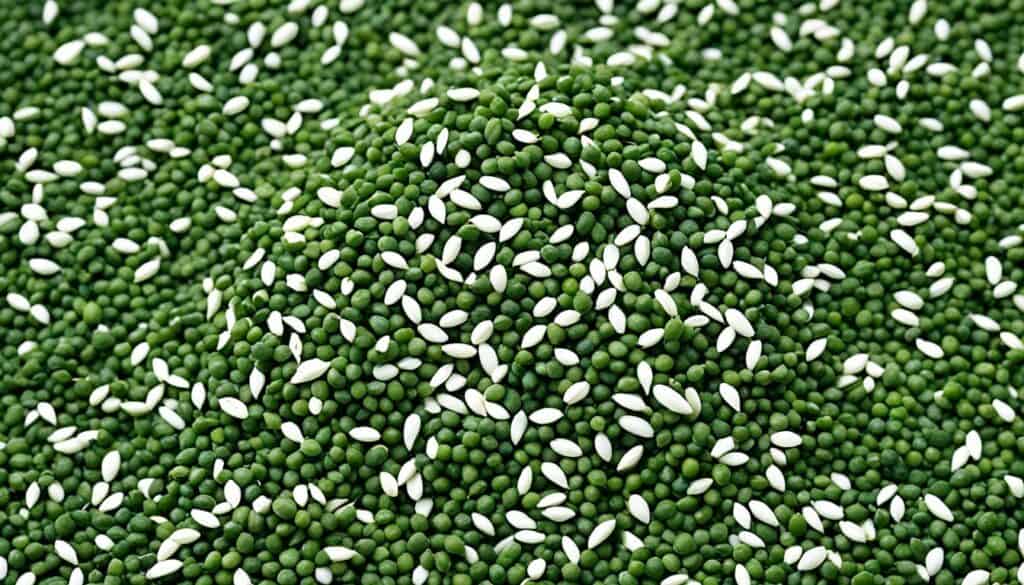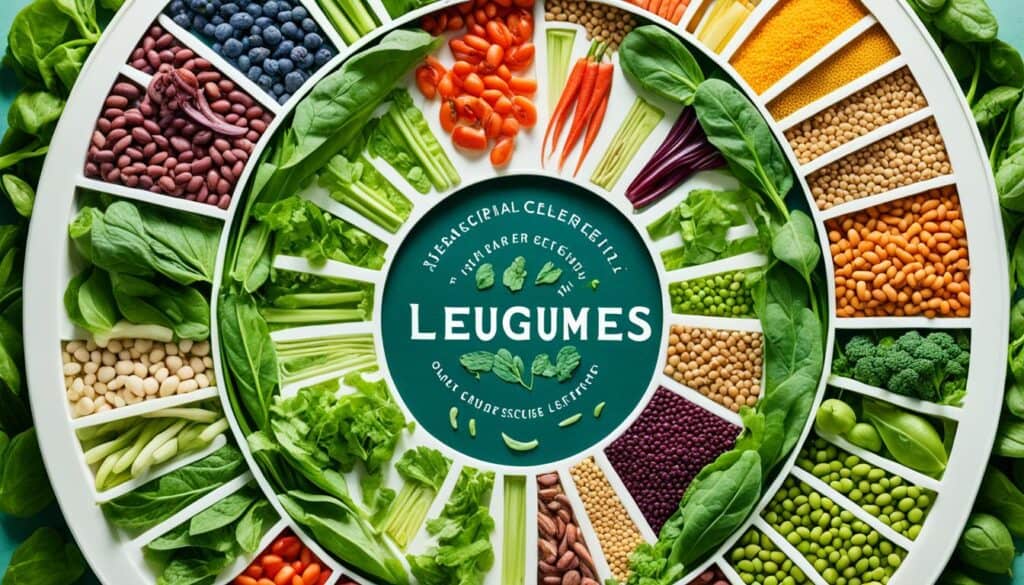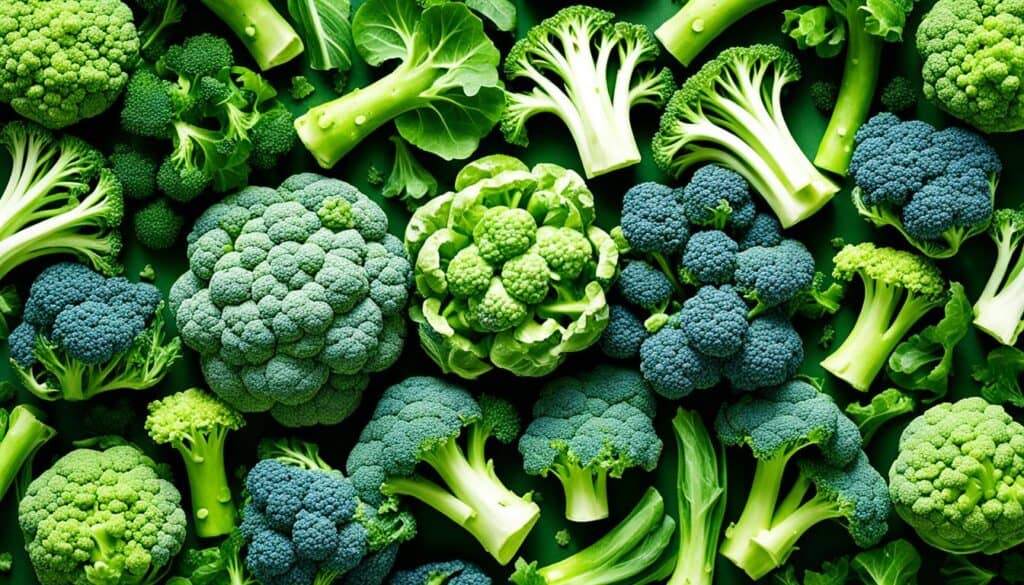Did you know that longevity spinach, also known as Gynura procumbens, has been revered for its health benefits for centuries? This powerhouse superfood not only offers exceptional nutritional value but also possesses incredible properties that can support your overall well-being. In this article, we will delve into the fascinating world of longevity spinach, exploring its numerous health benefits, and providing you with valuable tips on how to grow it successfully.
Key Takeaways:
- Longevity spinach is a superfood packed with essential nutrients for optimal health.
- Regular consumption of longevity spinach can support overall well-being and longevity.
- Growing longevity spinach can be a rewarding and cost-effective way to incorporate this nutritious plant into your diet.
- Stay tuned to discover the remarkable advantages of longevity spinach and unlock the secrets to a healthier life!
The Importance of Nutrient-Dense Foods for Longevity
Research has shown a strong connection between diet and longevity. What we eat impacts every process in our cells and can either support or hinder our longevity.
For those looking to live a long and healthy life, it is crucial to incorporate nutrient-dense foods into their diet. Nutrient-dense foods are those that provide a high concentration of essential vitamins, minerals, and antioxidants per calorie consumed.
By consuming nutrient-dense foods, we can optimize our body’s functions, boost our immune system, and reduce the risk of chronic diseases. These foods provide the necessary fuel and building blocks for our cells to function optimally, promoting overall health and longevity.
“Let food be thy medicine and medicine be thy food.” – Hippocrates
Incorporating nutrient-dense foods into our diet can have a profound impact on our health and well-being. These foods provide the necessary nutrients to support our bodily functions, including proper digestion, hormonal balance, and the repair and regeneration of cells.
Some examples of nutrient-dense foods include leafy greens, berries, nuts and seeds, lean proteins, whole grains, and fatty fish. These foods are packed with vitamins, minerals, fiber, and antioxidants that promote optimal health and longevity.
To give you an idea of the nutrient density of some common foods, here is a table showcasing the nutrient content per serving:
| Food | Calories | Protein (g) | Fiber (g) | Antioxidants (ORAC) |
|---|---|---|---|---|
| Spinach | 7 | 1 | 0.7 | 1,513 |
| Blueberries | 84 | 1 | 3.6 | 4,669 |
| Almonds | 164 | 6 | 3.5 | 4,454 |
| Salmon | 206 | 22 | 0 | N/A |
| Quinoa | 222 | 8 | 5 | N/A |
“Let thy food be thy medicine.” – Hippocrates
As you can see, these foods are not only low in calories, but they also provide a myriad of health benefits, including disease prevention, improved digestion, and increased energy levels.
By prioritizing nutrient-dense foods in our diet, we can nourish our bodies at the cellular level and support longevity. Let’s explore the benefits of incorporating specific nutrient-dense foods into our meals in the following sections.
Affordable Ways to Eat Healthy for Longevity
Eating healthy doesn’t have to be expensive. In fact, there are many affordable ways to incorporate longevity-promoting foods into your diet. By making smart choices and utilizing various strategies, you can prioritize your health without breaking the bank.
1. Meal Planning
One of the most effective ways to eat healthy on a budget is through meal planning. By taking the time to plan your meals for the week and creating a shopping list, you can avoid impulsive purchases and ensure that you have all the ingredients you need. This can help you save money by reducing food waste and preventing unnecessary trips to the grocery store.
2. Buying In-Season Produce
When fruits and vegetables are in season, they tend to be more abundant and less expensive. Take advantage of this by purchasing locally grown produce that is in season. Not only will you be supporting local farmers, but you’ll also be getting the freshest and most affordable options available.
3. Utilizing Frozen Foods
Frozen fruits and vegetables can be a convenient and cost-effective way to incorporate healthy ingredients into your meals. These frozen options often retain their nutritional value and can be just as nutritious as their fresh counterparts. They also have a longer shelf life, reducing food waste.
4. Shopping in Bulk
Buying in bulk can save you money in the long run, especially when it comes to staple items like grains, legumes, and nuts. Look for bulk bins at your local grocery store or consider joining a wholesale club. Just make sure to store these items properly to maintain their freshness.
5. Cooking at Home
Preparing meals at home not only allows you to have control over the ingredients you use but also helps you save money compared to dining out. With a little planning and creativity, you can create delicious and nutritious meals that are affordable and tailored to your specific dietary needs.
“Eating healthy on a budget is about making smart choices and prioritizing your well-being.”
– Mary Johnson, Nutritionist
6. Embracing Meatless Meals
Plant-based proteins, such as beans, lentils, and tofu, are not only affordable but also packed with nutrients. Incorporating more meatless meals into your diet can help you save money while promoting health and longevity. Experiment with various recipes and flavors to make your meatless meals exciting and satisfying.
7. Minimizing Processed Foods
Processed foods are often more expensive and less nutritious compared to whole, unprocessed options. By minimizing your consumption of processed foods and focusing on whole foods, you can improve your health while also saving money. Stick to the perimeter of the grocery store where fresh produce, whole grains, and lean proteins are usually found.
By implementing these affordable strategies, you can prioritize your health and longevity without straining your budget. Remember, eating healthy is an investment in yourself that pays off in the long run.
The Blue Zones and Longevity
In the quest for longevity, the Blue Zones offer valuable insights into healthy dietary habits and anti-aging foods. These regions are known for having a high concentration of centenarians, people who consistently live to be over 100 years old. It is fascinating to explore the dietary practices of these communities and how they contribute to their long and vibrant lives.
The Blue Zones prioritize a predominantly plant-based diet, with an emphasis on whole, unprocessed foods. These dietary habits align with the current understanding that plant-based nutrition can support longevity and overall well-being. By consuming minimal animal protein and focusing on economical, nutrient-dense foods, the Blue Zones exemplify a sustainable and health-promoting approach to eating.
In the Blue Zones, a variety of anti-aging foods take center stage. The residents prioritize fruits, vegetables, whole grains, legumes, and nuts, which are rich in vitamins, minerals, antioxidants, and fiber. These wholesome foods support optimal health, boost immunity, and provide essential nutrients for longevity.
As we delve deeper into the Blue Zones’ dietary practices, we discover the power of food in preventing age-related diseases and maintaining vibrant health. Through a balanced and diverse diet, these communities lower their risk of chronic conditions such as heart disease, cancer, and diabetes. Their commitment to healthy dietary choices contributes to their remarkable longevity.
The Blue Zones’ Dietary Principles
- Plant-Based Diet: The Blue Zones prioritize plant-based foods, consuming a wide range of fruits, vegetables, whole grains, legumes, and nuts.
- Minimal Animal Protein: Animal protein is consumed in moderation, with an emphasis on lean sources such as fish and poultry.
- Economical Whole Foods: The Blue Zones focus on affordable, whole food options that provide maximum nutritional value.
- Meal Rituals: Mindful eating practices, such as cooking at home, sharing meals with loved ones, and savoring each bite, are an integral part of the Blue Zones’ way of life.
The Blue Zones offer an invaluable blueprint for incorporating healthy dietary habits into our own lives. By embracing the principles of the Blue Zones and adopting a plant-centric diet rich in anti-aging foods, we can pave the way for a long and fulfilling life.
Fruits and Vegetables for Longevity
When it comes to promoting longevity, incorporating a variety of fruits and vegetables into your diet is key. These plant-based foods are packed with essential nutrients, antioxidants, and fiber that can support overall health and well-being. The Blue Zones, areas known for their high concentration of centenarians, place a strong emphasis on consuming abundant fruits and vegetables in their diets.
Fruits and vegetables provide a wide range of benefits for longevity. They are rich in vitamins, minerals, and phytochemicals that help protect against chronic diseases and promote healthy aging. Antioxidants, found in colorful fruits and vegetables, play a crucial role in neutralizing harmful free radicals and reducing oxidative stress in the body, which can contribute to the aging process.
Additionally, the high fiber content in fruits and vegetables supports digestive health and can help prevent conditions such as constipation and diverticulosis. Fiber also aids in maintaining a healthy weight by promoting feelings of fullness and reducing calorie intake.
Benefits of Fruits for Longevity
Fruits offer a variety of health benefits that can contribute to a longer and healthier life. Here are some key advantages:
- Rich in vitamins and minerals: Fruits are excellent sources of vitamins A, C, and E, as well as potassium, magnesium, and folate.
- Hydrating properties: Many fruits, such as watermelon and oranges, have high water content, helping to keep the body hydrated and support optimal organ function.
- Heart-healthy: Certain fruits, like berries and citrus fruits, are packed with antioxidants and flavonoids that can help lower the risk of heart disease.
Benefits of Vegetables for Longevity
Vegetables are nutritional powerhouses that offer numerous health benefits. Here are some reasons why they are essential for longevity:
- Nutrient-dense: Vegetables are low in calories but high in vitamins, minerals, and fiber, making them an excellent choice for maintaining overall health.
- Bone health: Leafy greens like kale and spinach are rich in calcium and vitamin K, which are essential for maintaining strong bones and reducing the risk of osteoporosis.
- Disease prevention: Research suggests that a diet rich in vegetables can help reduce the risk of chronic diseases, including certain cancers and cardiovascular conditions.
To incorporate more fruits and vegetables into your diet, try the following tips:
- Fill half your plate with fruits and vegetables at every meal.
- Experiment with different types of fruits and vegetables to add variety to your diet.
- Choose locally grown produce when possible, as it tends to be fresher and more flavorful.
- Snack on fruits and vegetables throughout the day to curb unhealthy cravings.
- Consider including a salad or a side of steamed vegetables with every meal.
By making fruits and vegetables the focal point of your meals, you can enjoy their myriad health benefits and contribute to a long and vibrant life.
Chia Seeds and Fiber for Longevity
When it comes to promoting longevity, incorporating nutrient-rich foods into your diet is key. One such food that deserves special attention is chia seeds. These small, yet mighty seeds are packed with fiber, protein, and omega-3 fatty acids, making them an excellent addition to a longevity-focused eating plan.
Fiber, found abundantly in chia seeds, plays a crucial role in supporting heart health. It helps reduce cholesterol levels, regulates blood pressure, and promotes proper digestion. By including fiber-rich foods like chia seeds in your diet, you can take proactive steps towards maintaining a healthy heart.
Another benefit of chia seeds is their positive impact on bone health. They are packed with essential minerals like calcium, phosphorus, and magnesium, which are important for strong and healthy bones. Incorporating chia seeds into your meals can help support your skeletal system and protect against conditions like osteoporosis.
So, how can you incorporate chia seeds into your daily meals? Here are a few simple and delicious ideas:
- Add a tablespoon of chia seeds to your morning smoothie for an added fiber boost.
- Sprinkle chia seeds over your yogurt or oatmeal for added crunch and nutritional value.
- Use chia seeds as an egg substitute in baking recipes for a plant-based twist.
- Create a refreshing chia seed pudding by mixing chia seeds with your favorite milk or yogurt and letting it sit overnight.
By including chia seeds in your meals, you can reap the many health benefits they offer, from promoting heart and bone health to supporting overall longevity.
Legumes for Blood Sugar Stability and Gut Health
When it comes to improving blood sugar stability and promoting a healthy gut, legumes are a powerhouse food group. Beans, lentils, and chickpeas are not only delicious but also loaded with essential nutrients that can contribute to your overall longevity.
Let’s explore the impressive benefits that legumes bring to the table:
| Nutrient | Amount per Serving (1 cup) |
|---|---|
| Fiber | Between 12-16 grams |
| Protein | Between 14-18 grams |
| Iron | Around 4-7 milligrams |
| Folate | Between 90-140 micrograms |
Legumes are rich in dietary fiber, which plays a crucial role in stabilizing blood sugar levels. The soluble fiber present in legumes slows down the absorption of glucose, preventing spikes and crashes in blood sugar. This benefit makes legumes an excellent addition to a balanced diet for individuals with diabetes or those looking to maintain steady blood sugar levels.
Besides their impact on blood sugar, legumes also bring incredible benefits to your gut health. As a fiber-rich food group, legumes act as prebiotics, providing nourishment for the beneficial bacteria in your gut. This promotes a healthy gut microbiome and supports optimal digestion, nutrient absorption, and overall gut function.
Ready to incorporate more legumes into your diet? Here are a few simple ideas:
- Add cooked chickpeas to salads for a protein and fiber boost.
- Enjoy a comforting bowl of lentil soup as a nutrient-dense meal.
- Blend cooked beans into spreads and dips for a tasty and nutritious snack.
Remember to soak dried legumes before cooking to improve digestibility and reduce cooking times. Canned legumes are also a convenient option if you’re short on time.
So go ahead, embrace the power of legumes and reap the benefits they offer for blood sugar stability, gut health, and ultimately, your longevity.
Cruciferous Vegetables for Detoxification and Heart Health
When it comes to nourishing your body and promoting longevity, cruciferous vegetables are a true powerhouse. Vegetables such as broccoli, cauliflower, kale, and Brussels sprouts not only add vibrant colors to your plate but also offer remarkable health benefits.
Detoxification: Cruciferous vegetables are rich in compounds that support the body’s natural detoxification processes. Sulforaphane, a potent antioxidant found in these vegetables, helps to activate detoxification enzymes in the body and eliminate harmful toxins. Including cruciferous vegetables in your diet can assist in keeping your body clean and revitalized.
Heart Health: The heart is at the center of our well-being, and supporting its health is crucial for longevity. Cruciferous vegetables, with their high fiber content and heart-healthy nutrients, contribute to cardiovascular well-being. Studies have shown that regular consumption of cruciferous vegetables can lower the risk of heart disease, lower blood pressure, and improve blood vessel function.
If you want to enhance your detoxification process and promote heart health, here are some ideas to incorporate more cruciferous vegetables into your meals:
- Add steamed broccoli to your stir-fries or salads.
- Roast cauliflower with olive oil, garlic, and your favorite spices for a delicious side dish.
- Sauté kale with some garlic and lemon juice as a nutrient-packed addition to any meal.
- Make a refreshing and crunchy coleslaw with shredded Brussels sprouts.
By including cruciferous vegetables in your diet, you can provide your body with essential nutrients while supporting detoxification and heart health. Enjoy the vibrant flavors and numerous benefits these vegetables bring to your plate and savor the path to a healthier, longer life.
Cruciferous Vegetable Recipe: Roasted Cauliflower with Turmeric
Turmeric, known for its anti-inflammatory properties, pairs well with roasted cauliflower, creating a flavorful and nutrient-dense dish. Here’s how you can prepare it:
- Preheat your oven to 425°F (220°C).
- Cut a medium-sized cauliflower head into florets.
- In a large bowl, toss the cauliflower florets with 2 tablespoons of olive oil, 1 teaspoon of turmeric, 1/2 teaspoon of cumin, and a pinch of salt and pepper.
- Spread the seasoned cauliflower evenly on a baking sheet.
- Roast in the preheated oven for 25-30 minutes, or until the cauliflower is tender and golden brown.
- Remove from the oven and serve as a side dish or as a flavorful addition to salads and grain bowls.
This vibrant and nutritious dish is a delightful way to enjoy the benefits of cruciferous vegetables and harness the anti-inflammatory properties of turmeric.
Leafy Greens for Disease Prevention
Incorporating leafy greens into your daily meals can significantly contribute to disease prevention and promote longevity. Leafy greens, such as spinach and arugula, are rich in essential nutrients and have been associated with a reduced risk of various diseases, including heart disease, stroke, diabetes, and certain cancers.
These vibrant greens are packed with antioxidants, vitamins, and minerals that support overall health and well-being. They are particularly high in vitamin K, which plays a crucial role in blood clotting and maintaining bone health.
Moreover, leafy greens are abundant in dietary fiber, which aids in digestion, promotes satiety, and helps regulate blood sugar levels. By incorporating leafy greens into your diet, you can support a healthy weight and reduce the risk of developing chronic conditions like obesity and diabetes.
To reap the maximum benefits of leafy greens, it’s essential to consume a variety of them. Different greens offer unique nutritional profiles and flavors. For instance, kale is rich in vitamin C and beta-carotene, while spinach provides ample amounts of iron and folate.
How to Incorporate Leafy Greens into Your Daily Meals
Here are some creative ways to include leafy greens in your diet:
- Add a handful of leafy greens to your daily smoothies for a nutrient-packed boost.
- Sauté leafy greens with a drizzle of olive oil and minced garlic for a simple and flavorful side dish.
- Include a generous amount of greens in your salads, along with other colorful vegetables and toppings.
- Substitute lettuce with leafy greens as a wrap or taco shell for a healthier alternative.
- Blend leafy greens into your favorite sauces, soups, or pesto for added nutrition.
Incorporating leafy greens into your daily meals is a delicious and effective way to support disease prevention and enhance your longevity. Experiment with different varieties of leafy greens to discover your favorites and enjoy the numerous health benefits they offer.
Nuts for Healthy Fats and Antioxidants
When it comes to promoting longevity, nuts are a delicious and nutritious addition to your diet. Packed with healthy fats, plant-based protein, and antioxidants, nuts offer a wide range of health benefits. Including a variety of nuts in your daily meals can improve heart health, aid in blood sugar balance, and support overall longevity.
Different types of nuts provide unique nutritional profiles, so it’s beneficial to incorporate a mix of varieties into your diet. Walnuts, for example, are rich in omega-3 fatty acids, which are known for their heart-healthy properties. Almonds, on the other hand, are a great source of vitamin E, which acts as an antioxidant and promotes healthy skin.
Adding nuts to your diet is an easy way to incorporate healthy fats and antioxidants. Their rich flavor and satisfying crunch make them a perfect snack or ingredient in a variety of dishes.
While nuts are packed with beneficial nutrients, it’s important to enjoy them in moderation. They are calorie-dense, so portion control is key. A recommended serving size is about a handful or 1-2 ounces per day. This ensures you reap the health benefits without consuming excessive calories.
Benefits of Nuts for Longevity:
- Healthy fats: Nuts are a great source of monounsaturated and polyunsaturated fats, which can improve heart health and lower the risk of heart disease.
- Antioxidants: Nuts contain antioxidants that help protect against oxidative stress and inflammation, both of which are linked to aging and chronic diseases.
- Plant-based protein: Nuts are an excellent plant-based protein source, which is essential for maintaining muscle mass and overall health as you age.
- Regulating blood sugar: The healthy fats and fiber in nuts can help stabilize blood sugar levels, reducing the risk of type 2 diabetes and promoting metabolic health.
So go ahead and enjoy a handful of nuts each day to boost your intake of healthy fats, antioxidants, and plant-based protein. Your heart, brain, and overall well-being will thank you!
Turmeric for Inflammation and Disease Prevention
Turmeric, with its active ingredient curcumin, is a powerful spice that has been used for centuries in traditional medicine. It is not only known for adding vibrant color and flavor to dishes but also for its numerous health benefits. One of the key advantages of turmeric is its ability to reduce inflammation in the body, which is a common underlying factor in many chronic diseases.
Chronic inflammation can lead to the development and progression of conditions such as heart disease, cancer, diabetes, and arthritis. By incorporating turmeric into your daily routine, you can support the body’s natural anti-inflammatory response and potentially reduce the risk of these diseases.
Curcumin, the active compound in turmeric, has been extensively studied for its anti-inflammatory properties. It works by inhibiting the activity of inflammatory enzymes and molecules in the body, thereby reducing inflammation at the cellular level.
Research has shown that curcumin’s anti-inflammatory effects are comparable to certain non-steroidal anti-inflammatory drugs (NSAIDs), but without the negative side effects associated with long-term use of these medications.
In addition to its anti-inflammatory properties, turmeric has also been found to have antioxidant, anticancer, antimicrobial, and immune-boosting effects. The combination of these properties makes turmeric a potent ally in disease prevention and overall well-being.
How to Incorporate Turmeric into Your Meals
There are many creative and delicious ways to include turmeric in your daily meals:
- Add a pinch of turmeric to scrambled eggs or omelets for a golden hue and added health benefits.
- Sprinkle turmeric on roasted vegetables or grilled meats to enhance flavor and boost nutritional value.
- Mix turmeric into smoothies or juices for a refreshing and immune-boosting beverage.
- Brew a cup of turmeric tea by steeping grated turmeric root in hot water, adding lemon or honey for taste.
- Incorporate turmeric into salad dressings, marinades, or sauces to elevate both the taste and health profile of your dishes.
Experiment with different recipes and find creative ways to incorporate turmeric into your favorite meals. The possibilities are endless!
Remember to consume turmeric with a source of fat, such as black pepper or avocado, to enhance its absorption. The active compounds in turmeric are fat-soluble, and the presence of fat can significantly increase their bioavailability.
Experience the many health benefits of turmeric by harnessing its anti-inflammatory properties and disease-fighting potential. By adding this golden spice to your meals, you can support your overall health and longevity.
Conclusion
Longevity spinach, when combined with a diet rich in nutrient-dense foods, holds the key to a long and healthy life. By following the example set by the Blue Zones and incorporating a variety of longevity-promoting foods into our diets, we can enhance our overall well-being and increase our chances of living a vibrant and energetic life.
Fruits and vegetables, such as spinach and kale, provide essential vitamins and minerals that support our immune system and protect against chronic diseases. Chia seeds, legumes, and nuts offer a wealth of plant-based protein, healthy fats, and antioxidants, which contribute to heart health, blood sugar balance, and overall longevity.
In addition, the powerful properties of turmeric, with its anti-inflammatory and disease-preventing benefits, can be harnessed by including it in our daily meals. By embracing these nutrient-dense foods, we nourish our bodies and pave the way for a healthier and longer future.
So let’s raise a toast, not just to the New Year, but to health and vitality in 2022! Cheers to a longevity-promoting diet that includes longevity spinach and an abundance of nutrient-dense foods. Here’s to taking the important steps towards a longer, healthier, and more fulfilling life.










Leave a Reply